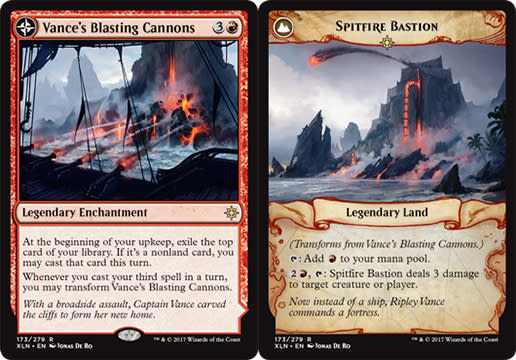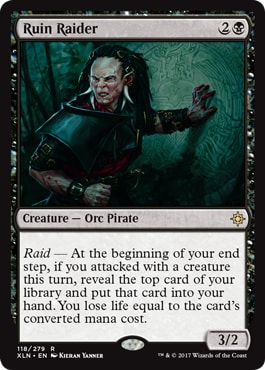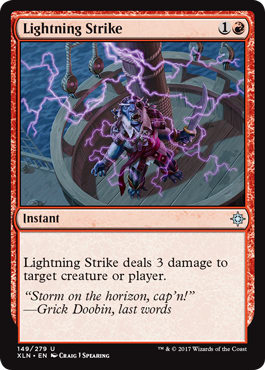While I originally didn’t intend on attending Ixalan’s inaugural event, SCG Dallas, a last minute decision to book a flight will see me playing my first Open since June. Whether or not I regret this decision will be almost entirely contingent on one thing; my deck choice. I seem to value deck selection significantly more than the majority of my peers in general, and I believe it’s even more important the first week of a format. In the middle of a format, the best deck for a given tournament tends to be only slightly better than the average deck in the field. The average player will show up with a strategy that has already been proven effective. But the disparity between the best deck and the average deck in the first tournament of a format is massive.
A large portion of the decks being played will have multiple glaring flaws. It’s for this reason that we often see aggressively slanted decks over perform in the early stages of a new Standard format. By taking an aggressive approach, you’re placing the onus of interaction on your opponent. And if your opponent’s deck isn’t properly configured to stymie your aggression, they’re going to be a pretty severe disadvantage. My Mardu Vehicles list from SCG Atlanta is the perfect example of a good week one deck.
Mardu Vehicles ? Amonkhet Standard | Andrew Jessup, 1st Place SCG Atlanta
- Creatures (18)
- 2 Archangel Avacyn
- 2 Thalia, Heretic Cathar
- 2 Walking Ballista
- 4 Scrapheap Scrounger
- 4 Thraben Inspector
- 4 Toolcraft Exemplar
- Planeswalkers (4)
- 4 Gideon, Ally of Zendikar
- Instants (8)
- 4 Fatal Push
- 4 Unlicensed Disintegration
- Sorceries (1)
- 1 Cut // Ribbons
- Artifacts (4)
- 4 Heart of Kiran
- Lands (25)
- 1 Mountain
- 2 Swamp
- 4 Plains
- 2 Aether Hub
- 2 Canyon Slough
- 2 Shambling Vent
- 4 Concealed Courtyard
- 4 Inspiring Vantage
- 4 Spire of Industry
- Sideboard (15)
- 1 Anguished Unmaking
- 1 Magma Spray
- 1 Cut // Ribbons
- 1 Fumigate
- 1 Painful Truths
- 2 Release the Gremlins
- 2 Transgress the Mind
- 2 Oath of Liliana
- 2 Nahiri, the Harbinger
- 2 Sorin, Grim Nemesis
Due to the emergency banning of Felidar Guardian just days before the tournament, there was almost no information available going into SCG Atlanta. The result of this was a metagame comprised almost solely of established decks and rough brews, and exploiting it was relatively easy. By simply playing a solid aggro deck with a good plan for the mirror, I was able to coast through tournament and claim my first Open title.
But in the single day of testing I had before the Open, I spent the entirety of it testing Aetherworks Marvel decks. Without the Saheeli combo in the format, it was quite apparent to me that Aetherworks Marvel would be the best deck going forward. I was right, and Aetherworks Marvel would go on to be banned after months of dominating the format. But the reason I didn’t play the deck in Atlanta, was that I wasn’t able to come up with a list that beat Mardu and various brews in such a short amount of time.
Tuning decks is an arduous process; it takes time. Time isn’t something people have a lot of in single week before a tournament, so the metagame for the Dallas Open should be easy predict as well. The most popular two decks will be Mono-Red and Temur Energy by a pretty wide margin, and the most represented new decks will be Dinosaurs followed by Pirates.
I’m aiming to replicate my success from Atlanta in Dallas, and my initial testing will certainly be focused on finding the best aggressive deck for the weekend. There are a few strategies that I think have a lot of potential, but the most obvious one is clearly Mono-Red.
Mono-Red ? Ixalan Standard | Andrew Jessup
- Creatures (26)
- 2 Kari Zev, Skyship Raider
- 4 Ahn-Crop Crasher
- 4 Bomat Courier
- 4 Earthshaker Khenra
- 4 Hazoret the Fervent
- 4 Rigging Runner
- 4 Soul-Scar Mage
- Instants (10)
- 2 Abrade
- 4 Lightning Strike
- 4 Shock
- Lands (24)
- 15 Mountain
- 1 Scavenger Grounds
- 4 Ramunap Ruins
- 4 Sunscorched Desert
- Sideboard (15)
- 2 Pia Nalaar
- 3 Glorybringer
- 2 Abrade
- 2 Aethersphere Harvester
- 2 Vance's Blasting Cannons
- 3 Chandra, Torch of Defiance
- 1 Scavenger Grounds
Mono-Red dominated Standard out of the gates in the last format, and I expect it to pick up where it left off. The only hit the deck takes is in the 1-drop slot, and I expect Rigging Runner to be a serviceable replacement to Falkenrath Gorger. The one awkward thing about Rigging Runner is that it actually compels you to play more Soul-Scar Mages. I was hoping that if there was a playable 1-drop in Ixalan it would mean getting to shave on Mages, but the raid ability on Rigging Runner incentivizes you to load up on 1-drops in order to consistently trigger it in the early game.
But aside from that, the core of the deck stays intact, and it even gets a few upgrades. Just by being an instant, Lightning Strike is a pretty big step-up from Incendiary Flow. With multiple mana sinks and Instants, Red now has a lot more flexibility when leaving up mana. With Incendiary Flow you were often forced to fire it off preemptively with incomplete information in order to maximize the use of your available mana, but with Lightning Strike you can wait until your opponent’s turn, so you have all the information you need in determining how to spend your mana and resources.
The other new card from Ixalan that I expect to be a staple in the sideboard of Mono-Red is Vance's Blasting Cannons. Not quite Outpost Siege is still an incredibly powerful card, and the back half is a solid add on. I don’t anticipate seeing many Spitfire Bastion in play, but when it does come up it can easily take over a game. While Vance's Blasting Cannons is a bit weaker than Chandra, Torch of Defiance and Hazoret the Fervent on raw power level, the playability of it can be attributed to its card type. The most notable benefit of being an enchantment is the fact that it dodges Vraska's Contempt.
Loading up on cheap removal was an ineffective way of tackling the Red deck in the last format because doing so left you weak to Red’s top end. But with Vraska's Contempt in the format, combating Red on this axis may be possible. Vraska's Contempt is a clean answer to Hazoret and Chandra, and it also aids you in getting out of burn range. If this proves to be the case, Vance's Blasting Cannons will become a pivotal part of Mono-Red’s postboard plan.
The deck still pressures opponents well, punishes opponents for trying to block, has plenty of reach in the form of burn spells and deserts, and can attack from multiple angles. At this point in time, it’s hard to even come up with reasons not to just jam Red. Hopefully I can figure something else out; but, if I end up sleeving up a bunch of Mountains, I won’t be too disappointed either.
Mono-Black Aggro ? Ixalan Standard | Andrew Jessup
- Creatures (28)
- 4 Dread Wanderer
- 4 Gifted Aetherborn
- 4 Glint-Sleeve Siphoner
- 4 Night Market Lookout
- 4 Ruin Raider
- 4 Scrapheap Scrounger
- 4 Vicious Conquistador
- Instants (4)
- 4 Fatal Push
- Sorceries (3)
- 3 Walk the Plank
- Artifacts (3)
- 3 Aethersphere Harvester
- Lands (22)
- 14 Swamp
- 4 Aether Hub
- 4 Ifnir Deadlands
- Sideboard (15)
- 4 Walking Ballista
- 2 Arguel's Blood Fast
- 2 Vraska's Contempt
- 4 Duress
- 1 Dispossess
- 2 Doomfall
I talked about coasting through the Atlanta Open earlier, but there was one hiccup along the way. I lost to a Mono-Black Aggro deck in the last round of the swiss, but the deck never picked up any steam. That was probably for good reason as it was rather mediocre, but it definitely had some things going for it. A few new editions from Ixalan could be exactly what it needed to push it into the realm of playability. There’s still a pretty good chance that there’s no reason to play Mono-Black over Mono-Red if you’re in the market for a consistent aggro deck, but there are some advantages Black has over Red. The question is if the advantages outweigh the deck’s shortcomings.
As I mentioned earlier, the 1-drop slot is where Mono-Red is at its weakest, but Mono-Black excels in that area. With the addition of Vicious Conquistador, you have access to twelve 1-drops that hit for two. This is critical because hitting hard is necessary in order to compensate for the deck’s lack of reach. The deck isn’t completely absent of reach, Night Market Lookout and Aethersphere Harvester can do some work, but you’re not going to win too many games after getting brickwalled. The upside is that this deck is likely even better than Red at slogging through removal. Between Dread Wanderer, Scrapheap Scrounger, Glint-Sleeve Siphoner, and Ruin Raider, getting one-for-oned out of the game will be an infrequent occurrence.
Ruin Raider is the card that actually makes this deck a potential contender. Between the undercosted creatures, cheap removal, and recursive threats, finding a spot to jam in should rarely be an issue. If you’re able to keep the cards flowing with Siphoner and Raider, burying your opponent should be simple regardless of your cards’ individual power level. The innate card advantage is also what allows the deck to get away with playing so many singular purpose removal spells.
But above all else, the biggest advantage Mono-Black possesses is that it appears to have the tools to actually beat Mono-Red. I’m not sure if my current list is solid against Red, but between cheap creatures that gain life, cheap removal, Aethersphere Harvester, and Vraska's Contempt, I don’t see a reason why this deck can’t be configured to beat Red. If the deck is able to consistently beat Red and it is aggressive enough to punish unpolished brews, it could be a real winner for week one.
Mardu Vehicles ? Ixalan Standard | Andrew Jessup
- Creatures (20)
- 2 Pia Nalaar
- 2 Walking Ballista
- 4 Inventor's Apprentice
- 4 Scrapheap Scrounger
- 4 Toolcraft Exemplar
- 4 Veteran Motorist
- Planeswalkers (2)
- 2 Chandra, Torch of Defiance
- Instants (8)
- 4 Lightning Strike
- 4 Unlicensed Disintegration
- Artifacts (6)
- 2 Aethersphere Harvester
- 4 Heart of Kiran
- Lands (24)
- 5 Mountain
- 5 Plains
- 2 Spire of Industry
- 4 Canyon Slough
- 4 Concealed Courtyard
- 4 Inspiring Vantage
- Sideboard (15)
- 2 Glorybringer
- 2 Walking Ballista
- 2 Abrade
- 2 Fumigate
- 2 Authority of the Consuls
- 2 Ixalan's Binding
- 1 Huatli, Warrior Poet
- 2 Chandra, Torch of Defiance
I touched on the deck a bit at the end of my last article, but after putting some more work into the list, I genuinely believe Mardu can still be a contender. I’m not the type of person to force an archetype because I have predilection for it; I actually think that the deck is solid. It does have to undergo some massive changes, though.
Despite appearing rather similar to the Mardu Vehicles lists we’ve grown accustomed to over the past year, this deck functions quite differently. The old Mardu decks we’re known for being these multifaceted piles of good cards. They attacked from countless angles and could adjust roles at whim. While there are still some elements of that present here, the deck is primarily a ![]()
![]() beatdown deck that utilizes Vehicles, Lightning Strike, and Unlicensed Disintegration for reach. So while Mardu is much easier for other decks to attack now, there are a few advantages that Mardu will have until the metagame adjusts. Early on in the format, I expect Lightning Strike to be very overplayed. This means that Abrade will be at an all-time low, allowing Mardu Vehicles to get a ton of mileage out of its namesake cards. And if you’re vehicles aren’t being targeting, getting your opponent into burn range shouldn’t prove to be too difficult of a task.
beatdown deck that utilizes Vehicles, Lightning Strike, and Unlicensed Disintegration for reach. So while Mardu is much easier for other decks to attack now, there are a few advantages that Mardu will have until the metagame adjusts. Early on in the format, I expect Lightning Strike to be very overplayed. This means that Abrade will be at an all-time low, allowing Mardu Vehicles to get a ton of mileage out of its namesake cards. And if you’re vehicles aren’t being targeting, getting your opponent into burn range shouldn’t prove to be too difficult of a task.
The sideboard is also a bit different than it used to be as well. While the plan is still to be able to adjust roles as needed, the mana restrictions and the dearth of solid Planeswalkers has made the plan a bit less potent. Overall, I’d still say Mardu has a better than average sideboard though, and it’s one of the strengths of the deck.
Being the three most aggressive archetypes that look promising, these are going to serve as the baseline for my initial testing. Ixalan was released on Magic Online just a little under an hour ago for me, and I can’t wait to hop in some leagues and start beating people down. I’ll have a few days to get some testing in, and I can start to get an idea of what my deck needs to look like in order to beat other aggressive decks while still being effective against emerging archetypes. Finding the balance here will be key.

























